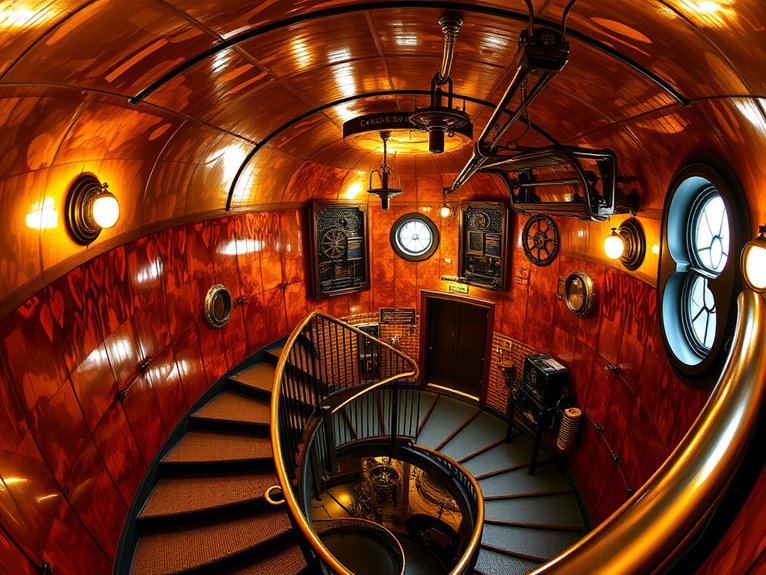
7 Best Paris Metro Stations With Remarkable Designs
I've discovered seven remarkable Paris Metro stations you won't want to miss! Arts Et Métiers dazzles with its copper-clad steampunk design, while Louvre-Rivoli showcases museum-quality artifacts. Don't skip Concorde's 45,000-tile word puzzle or Abbesses' stunning Art Nouveau entrance. Cité impresses as the deepest station, Bastille tells revolutionary tales, and Saint-Lazare lights up with modern installations. These underground treasures offer much more than just transportation – each station holds fascinating secrets waiting to be uncovered.
Arts Et Métiers: a Steampunk Fantasy Underground
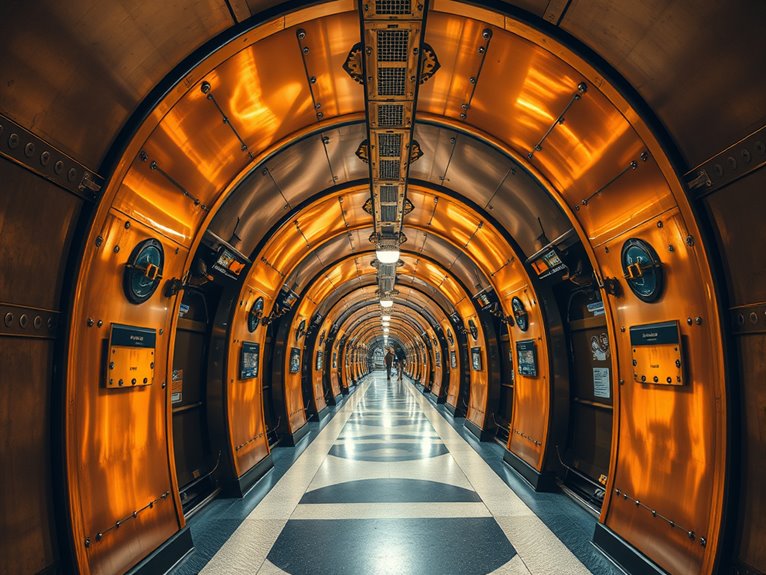
Step into a Jules Verne novel at Arts Et Métiers metro station, where copper-clad walls and mechanical elements transform an ordinary transit stop into a stunning steampunk masterpiece. This unique station, redesigned in 1994 by Belgian artist François Schuiten, pays homage to the nearby Musée des Arts et Métiers (Museum of Arts and Crafts) with its industrial revolution-inspired aesthetic.
The station serves as both a functional transit hub and an immersive art installation, making it one of Paris's most photographed metro stops. Every surface tells a story of scientific progress and industrial innovation, with massive gears, rivets, and portholes creating the illusion of being inside a gigantic submarine or time machine from a Victorian science fiction tale.
Quick Facts:
- Location: Line 3 and 11 intersection, 3rd arrondissement
- Best visiting times: Mid-morning or early afternoon on weekdays
- Photography: Permitted without flash or tripod
- Access: Regular metro ticket required (€1.90)
- Platform accessibility: Stairs and escalators available
- Best viewing: Platform of Line 11
The Copper Cathedral
The station's most striking feature is its complete copper cladding, covering walls, ceilings, and supporting structures. The warm, metallic surfaces create an otherworldly atmosphere that seems to glow under the station lighting. The copper has naturally patinated over time, adding authentic character to the steampunk aesthetic. Insider tip: The most dramatic photos can be captured from the middle of the platform, where the curved walls create perfect symmetry.
Industrial Art Details
Throughout the station, carefully crafted mechanical elements integrate seamlessly with functional features. Giant cogs appear to emerge from walls, while portholes double as lighting fixtures. The design pays tribute to the scientific instruments and inventions housed in the museum above. Lesser-known detail: Look for the subtle variations in the gear patterns – each section tells a different story about industrial progress.
Pro Tips:
The best time to photograph and appreciate the station's unique design is during off-peak hours, particularly between 10:30 AM and 4:00 PM on weekdays. The copper surfaces react differently to changing light conditions throughout the day, with mid-morning offering the warmest tones. For the ultimate steampunk experience, combine your station visit with a trip to the Musée des Arts et Métiers above ground.
Practical Advice:
While the station is a public transit space, respect other passengers by not blocking foot traffic during photography sessions. The platform can get crowded during rush hours (8:00-9:30 AM and 5:00-7:00 PM), so plan your visit accordingly. Keep your metro ticket handy, as you may need to show it to station staff, and consider purchasing a carnet (book of 10 tickets) if you plan to visit multiple artistic metro stations throughout Paris.
Louvre-Rivoli: The Underground Museum Gallery
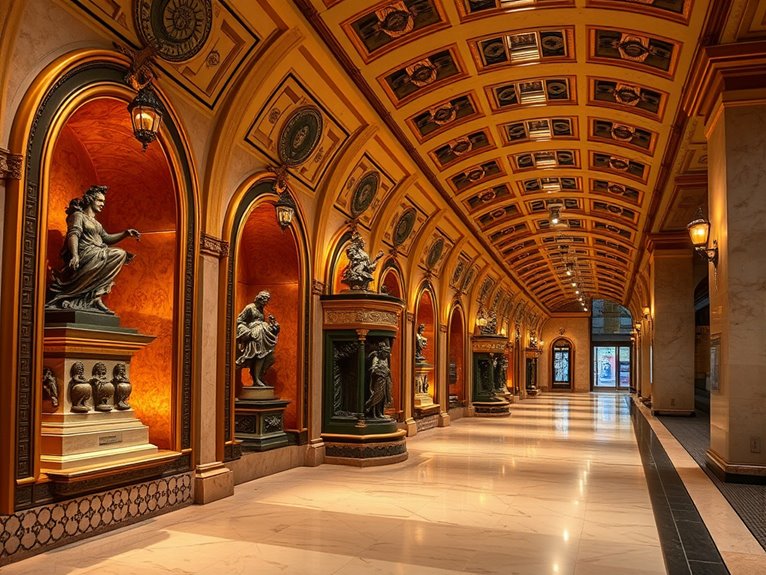
Step into Louvre-Rivoli station, where the Paris Metro transforms into an extraordinary underground museum celebrating the treasures housed in the nearby Louvre Museum. This remarkable station, located on Line 1, stands as a tribute to the city's commitment to making art accessible to everyone, featuring high-quality replicas of sculptures and artifacts that mirror the collections above ground.
The station's 1989 renovation established it as one of Paris's most culturally significant metro stops, offering commuters and tourists alike a free glimpse into the world's largest art museum. Glass display cases line the platform walls, containing carefully curated reproductions of classical sculptures, while the station's vaulted ceilings and stone walls create an atmosphere reminiscent of the museum's ancient galleries.
Quick Facts:
- Best visiting times: Mid-morning or early afternoon on weekdays
- Photography: Permitted, no flash required due to excellent lighting
- Access: Line 1 (yellow line)
- Platform location: -3 level (underground)
- Crowd levels: Highest during museum opening hours
- Special features: 12 display cases featuring artwork replicas
- Accessibility: Elevator available
The Artistic Display
The station's main attraction lies in its carefully curated collection of replica sculptures and artifacts, positioned within illuminated niches along both platforms. These pieces represent various periods and civilizations featured in the Louvre, from ancient Egyptian artifacts to Classical Greek sculptures. The lighting design specifically highlights each piece, creating dramatic shadows and depth that enhance the viewing experience.
Platform Architecture
The station's architectural design mirrors classical museum galleries, with stone-clad walls and arched ceilings creating an elegant, gallery-like atmosphere. The platform features special lighting fixtures that minimize glare on the glass cases while providing ideal viewing conditions for the artwork. An insider tip: the western end of the platform offers the best photo opportunities with fewer commuters passing through.
Pro Tips:
Visit during off-peak hours (10:00-11:30 AM or 2:00-4:00 PM) to explore the displays without rushing. The station's artificial lighting remains constant throughout the day, making it perfect for photography at any time. Position yourself near the center of the platform for the best panoramic views of multiple display cases at once. Many visitors miss the detailed informational plaques beside each piece – these contain fascinating historical context in both French and English.
Practical Advice:
While the station serves as a convenient access point to the Louvre Museum, consider it a destination in itself. Allow 15-20 minutes to properly explore the displays. Keep your metro ticket accessible as you might need to show it to station agents if you spend extended time photographing the artwork. The station maintains a comfortable temperature year-round, making it an excellent refuge during extreme weather while still enjoying cultural attractions.
Concorde: The Giant Word Puzzle Station
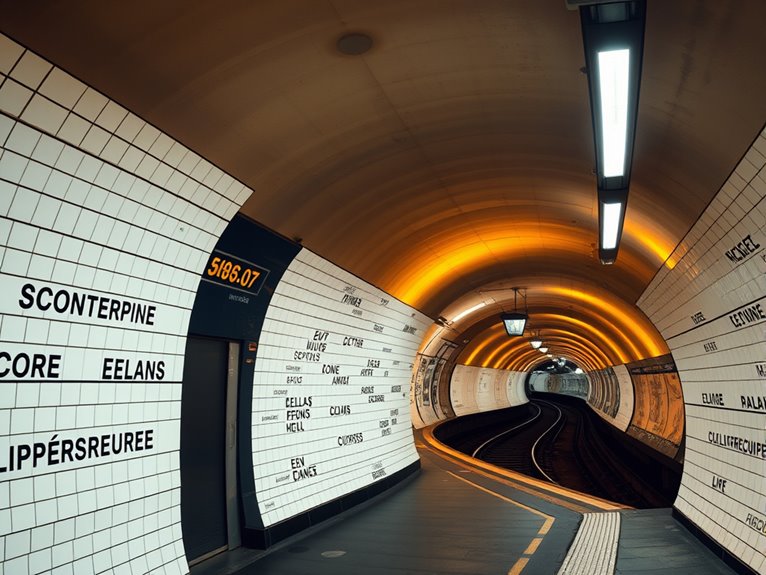
The Concorde metro station stands as one of Paris's most striking examples of conceptual art in public transportation, transforming an ordinary subway stop into an immersive literary experience. The station's walls are covered with 45,000 letter tiles, spelling out the complete text of the 1789 Declaration of the Rights of Man and of the Citizen, creating a massive word-search puzzle that captivates both locals and tourists alike.
Originally redesigned in 1991 by artist Françoise Schein, this unique installation celebrates both French history and contemporary art while serving as a daily reminder of human rights and democracy. The seemingly random pattern of letters, when decoded, reveals one of France's most important historical documents, making it not just a transit point but a cultural landmark that encourages reflection on civil liberties and social justice.
Quick Facts:
- Best visiting times: 10:00-16:00 (fewer commuters)
- Photography: Allowed, but no flash
- Location: Lines 1, 8, and 12 intersection
- Access: Regular metro ticket required
- Lighting conditions: Artificial, consistent throughout day
- Average viewing time: 15-20 minutes
- Accessibility: Elevator available at certain entrances
The station's artistic centerpiece spans the entire platform length, with letters arranged in a strict geometric pattern without spaces or punctuation. The text appears in black and white tiles, creating a striking visual contrast that draws the eye across the walls. The installation required over 180,000 individual tiles and took nearly a year to complete. The station serves approximately 50,000 passengers daily and connects three major metro lines at the heart of Paris's 8th arrondissement.
Pro Tips:
Visit during off-peak hours to fully appreciate the artwork without crowds. The best photographs can be captured from the center of the platform, where the curved walls create an interesting perspective. Consider bringing a small notebook to attempt decoding portions of the text – many visitors make a game of finding specific words or phrases within the giant puzzle.
For practical navigation, use the station's northern exit to reach Place de la Concorde and the Tuileries Garden. The station can be particularly crowded during rush hours (8:00-9:30 and 17:00-19:00), so plan accordingly if you wish to study the artwork in detail. Remember that metro tickets are valid for transfers between lines, allowing you to explore the station thoroughly without additional cost.
Abbesses: The Art Nouveau Masterpiece
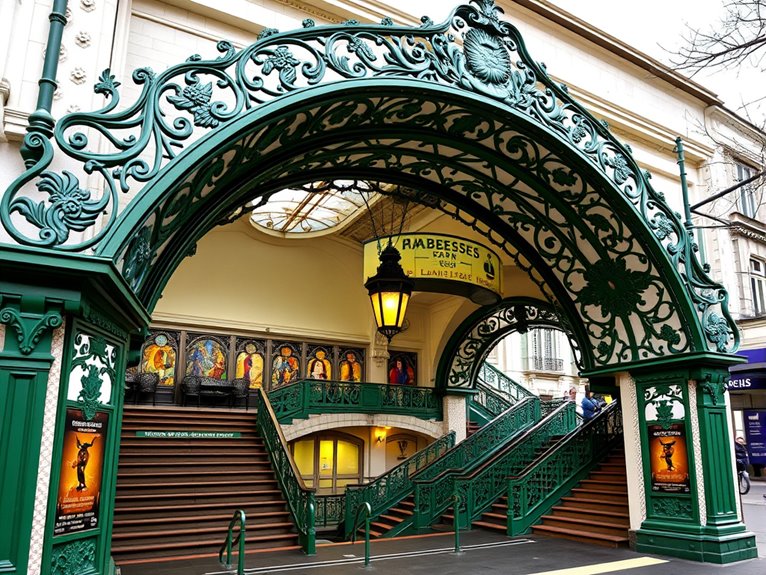
Nestled in the heart of Montmartre, Abbesses metro station stands as one of Paris's most striking examples of Art Nouveau architecture and design. Opening its ornate entrances to the public in 1912, this historic station showcases the distinctive aesthetic of Hector Guimard, whose iconic green metalwork entrances have become synonymous with Parisian metro culture.
As one of only two remaining original Art Nouveau entrances in Paris (the other being Porte Dauphine), Abbesses offers visitors more than just a transit point – it's a living museum of early 20th-century decorative arts. The station's elaborate entrance canopy, with its sinuous organic forms and delicate glass work, exemplifies the movement's celebration of natural forms and innovative industrial materials.
Quick Facts:
- Best visiting times: Early morning (7-9am) or late evening (8-10pm) for fewer tourists
- Photography: Permitted without flash or tripod
- Depth: One of the deepest stations (36 meters underground)
- Access: Line 12
- Historical status: Listed as a historic monument since 1978
- Elevator availability: Limited (spiral staircase primary access)
The Station's Design:
The entrance pavilion features Guimard's signature style, with flowing cast iron forms resembling plant stems and flower buds. The iconic "Métropolitain" sign is spelled out in distinctive Art Nouveau lettering, set against a background of amber glass and green-painted metalwork. The station's original ceramic tiles and decorative elements remain largely intact, making it one of the most authentic examples of Art Nouveau metro design worldwide.
Interior Features:
Beyond the famous entrance, the station's interior spiral staircase descends through a remarkable 36 meters, decorated with beautiful murals depicting scenes from Montmartre's history. These artworks, added in later renovations, create a museum-like experience for visitors brave enough to tackle the 180 steps. Insider tip: Look for the hidden artist signatures in the corner of each mural panel.
Pro Tips:
For the best photographic opportunities, visit during "golden hour" just before sunset when the metalwork catches the warm light. Consider ascending the stairs rather than descending, as the spiral design creates more interesting compositional opportunities when shooting upward. Photographers should also note that early Sunday mornings offer the least crowded conditions for capturing the station's architectural details.
Practical Advice:
While Abbesses is a must-see for architecture enthusiasts, those with mobility issues should be aware that the elevator service is unreliable and the spiral staircase can be challenging. Visit as part of a broader Montmartre exploration, combining it with nearby attractions like Sacré-Cœur and Place du Tertre. Keep your metro ticket handy, as you'll need it to exit through the turnstiles even if you're just visiting for photos.
Cité: The Cathedral of Metro Stations
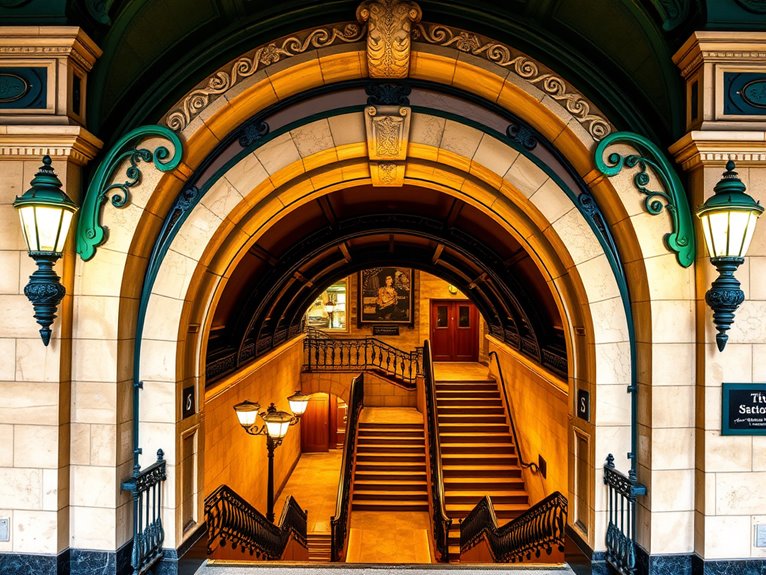
Descending into Cité metro station feels like entering a subterranean cathedral, with its vaulted ceilings, dramatic lighting, and grand architectural details that echo the Gothic splendor of nearby Notre-Dame. Located on Line 4 beneath the Île de la Cité, this remarkable station has been enchanting Parisians and tourists alike since its inauguration in 1910, standing as a proof of the Art Nouveau movement that shaped Paris's metro aesthetic.
Beyond its role as a transit point, Cité station represents the pinnacle of metro station design during Paris's Belle Époque period. Its unique position as the deepest station in Paris (20 meters below ground) allowed architects to create soaring spaces that showcase innovative engineering and artistic vision, making it a must-visit destination for architecture enthusiasts and photographers.
Quick Facts:
- Best visiting times: 10:00-16:00 on weekdays for fewer crowds
- Photography allowed without tripods or professional equipment
- Free to view with valid metro ticket (€1.90)
- Accessible via Line 4
- Platform length: 75 meters
- Original copper light fixtures still in use
- Temperature remains constant at 14-16°C year-round
The station's most distinctive feature is its series of massive globe lamps suspended from ornate bronze arms, casting a warm, golden glow throughout the space. These original fixtures, designed by André Dervaux, have been carefully preserved and restored to maintain their century-old charm. The walls feature white tiles arranged in a subtle curve pattern, creating an illusion of movement and depth that was revolutionary for its time.
The platform level showcases exceptional craftsmanship in its cast iron columns and decorative brackets, painted in the signature green color of the Paris Metro. Less obvious but equally impressive are the acoustic properties of the station's design – stand at certain points along the platform, and you'll experience unique sound effects created by the curved ceiling structure.
Pro Tips:
For the best photographic opportunities, visit during off-peak hours when trains are less frequent. The most dramatic shots can be captured from the middle of the platform, where the perspective of the curved ceiling and repeating light fixtures creates a stunning vanishing point. Consider visiting during seasonal events when the station occasionally hosts art installations or classical music performances, transforming the space into an even more magical environment.
Practical Advice:
While exploring Cité station, remember that it remains an active transit point. Plan your visit between trains to safely photograph the architecture, and be mindful of commuters during rush hours (8:00-10:00 and 17:00-19:00). The station's proximity to Notre-Dame Cathedral makes it an ideal starting point for exploring the Île de la Cité, but note that the station's deep position means relying on elevators that can sometimes be crowded or temporarily out of service.
Bastille: Revolutionary History Below Ground
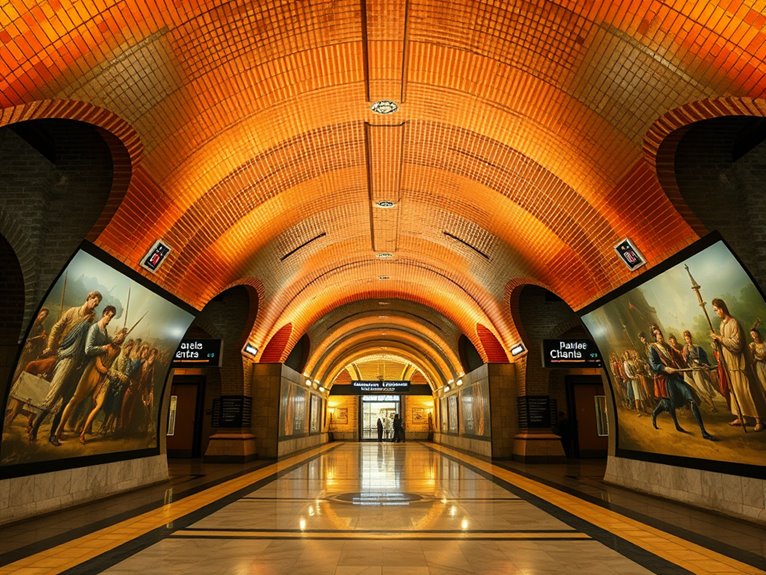
The Bastille metro station stands as a powerful representation of Paris's revolutionary past, seamlessly blending historical significance with artistic innovation. Located beneath the iconic Place de la Bastille, where the infamous prison once stood, this metro hub serves as both an essential transportation nexus and a living museum chronicling the French Revolution.
Designed by architect Jean-Claude Daufresne, the station's most striking feature is its dramatic Revolutionary-themed murals and architectural elements that pay homage to the storming of the Bastille in 1789. The platform walls showcase detailed chronological illustrations of the revolution, while innovative lighting techniques create an atmosphere that transports commuters back to 18th-century Paris.
Quick Facts:
- Peak Hours: Avoid 8-10am and 5-7pm on weekdays
- Photography: Best lighting conditions between 11am-2pm
- Access: Lines 1, 5, and 8 intersect here
- Platform Access: Multiple elevators available
- Historical Displays: Free viewing, no special ticket required
- Best Visiting Time: Early Sunday mornings for minimal crowds
The station's main hall features "The Revolutionary Frieze," a stunning 180-foot ceramic mural depicting scenes from the French Revolution. Created in 1989 to commemorate the revolution's bicentennial, this masterpiece incorporates authentic historical documents and period illustrations. Look for the hidden markers in the floor tiles that indicate where the original fortress walls once stood.
A unique feature of Bastille station is its "Sound Garden" installation, tucked away in a less-traveled corridor between Lines 1 and 5. This interactive art piece produces revolutionary-era music and sound effects when passengers walk through specific sections, creating an immersive historical experience. Insider tip: Stand near the middle of the corridor for the best acoustic effect.
The station's architectural design incorporates actual stones from the original Bastille prison, visible behind protective glass near the Line 5 platform. These artifacts provide a tangible connection to the site's historical significance, though many visitors miss them entirely. The best viewing spot is from the far end of the platform, where special lighting illuminates the stonework.
Pro Tips:
For the most enriching experience, download the free RATP Art & Culture app before visiting. It provides an augmented reality tour of the station's historical elements and artwork, with detailed explanations in multiple languages. Visit during off-peak hours to fully appreciate the intricate details without rushing through crowds.
Practical Advice:
While exploring the station's historical features, keep your belongings secure and maintain awareness of your surroundings, as this is one of Paris's busier metro stops. Purchase a carnet (book of 10 tickets) if planning to visit multiple metro art stations, as it's more economical than single tickets. Store your ticket until exiting the station, as spot checks are common at this location.
Saint-Lazare: Modern Art Meets Metro Design
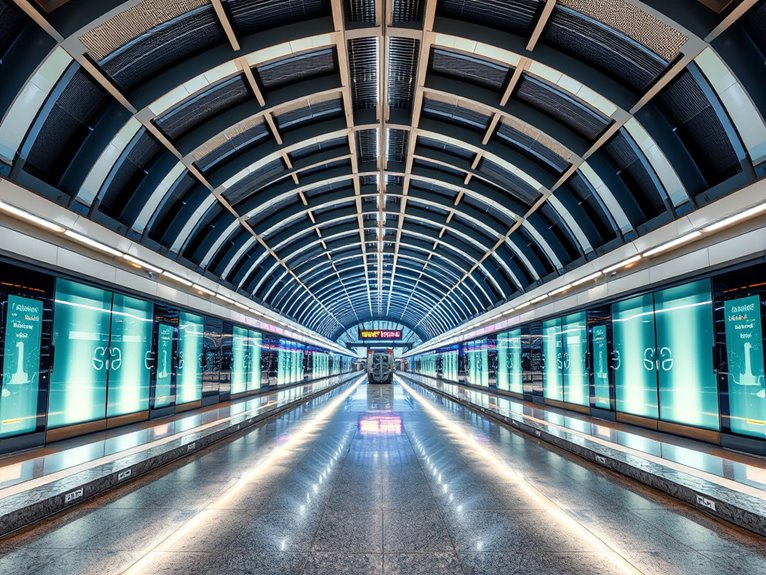
Saint-Lazare metro station stands as a proof of Paris's commitment to blending functional public transportation with striking artistic expression. This major transportation hub, serving over 100 million passengers annually, has been transformed into an underground gallery where contemporary design meets classical architecture, making it one of the most visually compelling stations in the Paris Metro system.
The station's recent renovation masterfully incorporates modern art installations while preserving its historical essence dating back to 1904. The most notable feature is the "Metroscope" light installation, which creates an ever-changing pattern of illumination that responds to passenger movement, turning everyday commutes into interactive art experiences.
Quick Facts:
- Peak Hours: 8:00-10:00 AM and 5:00-7:00 PM on weekdays
- Photography: Allowed without tripods or professional equipment
- Best Viewing Times: Mid-morning or early afternoon for ideal lighting
- Access: Lines 3, 12, 13, and 14
- Architectural Style: Modern minimalist mixed with Belle Époque elements
- Connected to: Saint-Lazare train station and shopping complex
The Metroscope Installation
The centerpiece of Saint-Lazare's artistic design is the dynamic light installation that spans the main corridor. Created by artist Thierry Dreyfus, this sophisticated LED system responds to passenger flow, creating a living artwork that changes throughout the day. The installation is best viewed during off-peak hours when fewer passengers allow for unobstructed appreciation of the light patterns.
Architectural Integration
The station's design seamlessly integrates modern elements with its historical framework. The white-tiled walls are complemented by brushed steel fixtures and geometric lighting patterns. The renovation preserved the original Art Nouveau entrance signs while introducing contemporary wayfinding systems. An often-overlooked detail: the acoustic engineering creates unique sound patterns that change as you move through different sections of the station.
Art Gallery Corridors
The transfer corridors between lines feature rotating exhibitions of contemporary art, making Saint-Lazare a legitimate underground museum. These spaces showcase both established and emerging artists, with exhibitions changing quarterly. Insider tip: the least crowded viewing time is typically Sunday mornings before 11:00 AM.
Pro Tips:
The best photographs of the Metroscope installation can be captured from the middle of the main corridor, facing either direction during off-peak hours. For architecture enthusiasts, the morning light filtering through the street-level entrances creates dramatic shadows and lighting effects between 9:00 and 10:00 AM. Consider visiting during the annual Nuit Blanche festival when the station features special light shows and art installations.
Practical Advice:
While exploring Saint-Lazare's artistic elements, remain aware of commuter flow patterns. The station can become extremely busy during rush hours, making art appreciation challenging. Store maps are available at the information desk, marking the locations of major art installations and ideal viewing points. The station's multiple exits lead to different street levels, so orient yourself using the color-coded exit maps to avoid confusion when departing.
